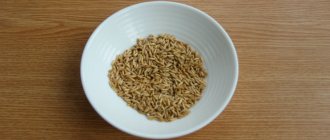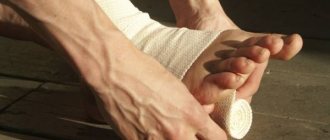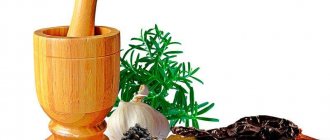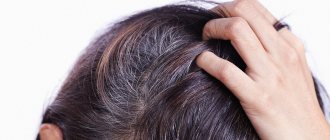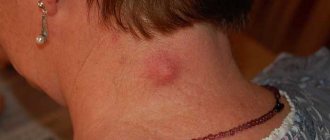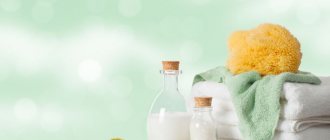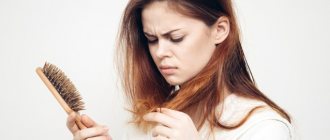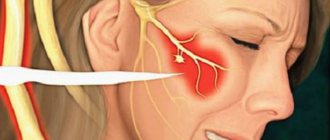Treating seborrhea with salt is the most effective method
Attempts to get rid of dandruff using various shampoos and medications in most cases do not bring success. However, there is a very effective folk remedy against seborrhea - coarse salt, preferably sea salt.
After removing dirt from the head using regular shampoo (any detergent familiar to a particular person will do), salt should be rubbed into still damp hair. In this case, the coarsest salt is needed. Massage with salt should be performed for several minutes.
The effect of such a gentle peeling is as follows:
- Hair loss stops;
- There is a gentle exfoliation of dead skin particles;
- The skin is not injured, since the salt melts from moisture;
- Blood circulation increases.
After the procedure, the hair is washed with plain water. You can do this over a container and rinse your head again with the collected salt water. Visible dandruff will disappear after the first procedure. Over time, the hair will become thicker and thicker. You can perform this peeling every time you decide to wash your hair. For preventive purposes, 1 procedure every 1-2 weeks is sufficient.
Two more ways to get rid of dandruff and prevent alopecia using salt:
- Dissolve regular salt in water (it should be very hot) and then dip a soft cloth in it. It is best to use linen or cotton based material. When the fabric is saturated with the solution, wrap it around your head and massage it for half an hour. As a result, blood circulation improves, and the skin does not suffer from irritation due to direct exposure to salt particles.
- The hair is pre-moistened, and then salt is applied to it using massage movements. Then the head should be left alone for 20 minutes. After time, the salt is washed off, but shampoo is not used for this. Rub any nourishing mask into your hair or use a rinse. Let your hair dry naturally.
It is enough to use these recipes once or twice a week.
It is worth remembering that salt dries out the scalp. Its use is not recommended for people with dry hair, as it can aggravate the situation and lead to an increase in the amount of dandruff.
Salt peeling
Treatment of the disease
Seborrhea therapy is carried out only in a comprehensive manner. It is important to use medicinal hair and scalp care products at home. At the same time, you should take medications and see a doctor.
Seborrhea can be treated in ways that doctors use:
- The use of drugs that restore the functioning of the nervous system.
- Therapy of chronic diseases.
- Use of hormonal drugs.
- Dieting. It is worth consuming more fermented milk products, fresh vegetables and fruits, eggs, and oatmeal. It is necessary to remove animal fats, canned food, and spicy foods from the diet. All this will help avoid complications and normalize gastrointestinal functions.
- Take vitamins A, B, E, D, zinc, sulfur. With these elements, the body will be able to cope with such an illness on its own.
- Physiotherapeutic procedures. Massage, ultraviolet irradiation, cryotherapy and others will have a good effect.
- Physical activity and exercise will improve blood flow and metabolic processes in the body.
- If you have seborrheic dermatitis, try to walk more without a hat (but only in the warm season) and expose your head to the sun's rays more often, just not in the hottest sun.
To get rid of dry seborrhea, you can use an ointment that contains sulfur, salicylic acid, and in some cases even hormones. They are also suitable for oily seborrhea, only you need to add chloral hydrate and resorcinol to them. Alcohol solutions are also used.
Apple cider vinegar 6% for seborrhea
Another folk remedy that helps in the treatment of seborrhea is apple cider vinegar at a concentration of 6%.
It can be beneficial for hair due to the following properties:
- It contains B vitamins, ascorbic acid, and carotene.
- Vinegar, like apples, contains pectin.
- It helps not only cleanse the scalp, but also regenerate microtraumas. Vinegar can neutralize pesticides.
This product has been used for a long time as a way to preserve the beauty of hair and improve the health of the scalp. Vinegar is effective against dandruff due to its ability to normalize the acid-base balance.
Hair rinse (has a disinfecting effect). Four tablespoons of vinegar in a 5% concentration are diluted in a glass of water. Rinse your hair with this solution several times, focusing on the roots. Afterwards, you need to rinse your head with water.
Mask No. 1. Vinegar in a 5% concentration is applied to a sponge and then to the dermis of the head. Leave for up to 20 minutes and wash with water.
Mask No. 2. Two tablespoons of 5% vinegar are diluted in half a glass of water. It should be at room temperature. A decoction of chamomile, mint or oil (castor or burdock) is also added there. The composition is rubbed into the scalp and covered with polyethylene and a towel. If you wish, you can turn on the hairdryer for one minute and warm up the mask (you can repeat the warming up several times). Leave the mask on for an hour and then wash off with water. Shampoo is not used.
Both recipes can be used twice a week. The course of treatment is 30 days.
Traditional treatment recipes
Folk remedies are a risky activity, because it is not known what exactly disrupts the functions of the sebaceous glands. This is due to a failure in one of the body systems. Treatment of seborrhea of the scalp with various folk remedies can only remove the symptoms for a while.
To diagnose such a disease, a specialist will need to collect the patient’s medical history and refer him for tests and ultrasound examination. If the patient is a woman, then a referral will be issued to him. After the diagnosis has been made, it is necessary to identify the cause of the disease.
To relieve symptoms of any type of seborrhea, doctors recommend home treatment using traditional methods.
There are a huge number of them, so let’s look at the main ones. They use publicly available components.
- Combine equal amounts of baking soda, glycerin and water. Mix thoroughly to form a paste. Apply the mixture as a mask to the roots, rubbing lightly, about half an hour before washing your hair. Baking soda will help improve blood flow, and glycerin will soften the crusts that have formed.
- Collect the green leaves of the wollo nut, cut into small pieces to make six spoons. Pour half a liter of boiling water over them and cook after boiling for three minutes. Remove from heat and cool at room temperature, then soak a towel generously with this broth, wrap your hair in it and cover with foil. After thirty minutes, rinse with running water. This must be done every other day until the disease subsides.
- If a patient has an oily type of disease, chamomile infusion will help him. This plant heals wounds and reduces the amount of fat secreted. This infusion is very easy to prepare. Take thirty grams of dry chamomile and pour boiling water (one liter jar), leave for fifteen minutes, and then wash your hair with it.
- Take one tablespoon each of castor oil, liquid honey, onion juice and one yolk. Mix everything thoroughly and apply to the hair roots. Then wrap your hair in heat and leave for two hours. Then rinse to remove the smell.
- A mask with mustard will help a lot. You need to mix twenty grams of mustard, a teaspoon of liquid honey, ten milligrams of castor oil and burdock and one yolk. Mix everything thoroughly and spread on your hair. Wrap in plastic and a towel.
After fifteen minutes, rinse with shampoo, then rinse with a solution of water and vinegar. Later, it is necessary to increase the time of holding the mask to an hour. Do this every three days.
These are recipes suitable for any seborrhea, but there are separate ones that are used for each type.
Sulsena paste 2% and shampoo - the best remedy for seborrhea
Sulsena is a pharmaceutical remedy that helps in the treatment of seborrhea. The drug has two forms of release: paste and shampoo. They are almost identical in composition. To provide a therapeutic effect, they must be used topically, that is, applied in accordance with the instructions to the hair and scalp. According to manufacturers, the maximum effect can be obtained from the combined use of paste and shampoo.
The active ingredient that helps get rid of dandruff is selenium disulfide. It works like this:
- Destroys fungus that causes dandruff;
- Regulates the activity of the sebaceous glands;
- Regulates the rate of exfoliation of dermal particles by reducing the lifespan of epithelial cells.
As a result, all three main problems that stimulate the development of dandruff are solved. However, it is worth preparing for a long course of treatment. You won't be able to get instant results. The minimum duration of therapy is 3 months. Wash your hair with shampoo once a week. Before washing it off, leave the product on your hair and skin for up to 4 minutes.
The paste is applied to pre-washed hair, massaging the skin. Leave the product on your head for up to 20 minutes and then rinse off. As a preventive measure, it is enough to use these products once every six months for 30 days. In addition to getting rid of dandruff, using
Sulsen allows you to achieve the following effects:
- Healthy hair shine;
- Hair thickness, as hair loss is reduced;
- Hair does not require washing longer, as the product regulates the functioning of the sebaceous glands;
- The scalp stops itching;
- Reduces the formation of exogenous toxins that have a negative effect on the hair roots;
- Scalp cells become healthier;
- Hair follicles function better;
- Hair becomes more elastic.
The effect of using Sulsena is long-lasting, so the risk of dandruff recurrence when completing the full course of therapy and subject to its prophylactic use is minimal.
Types and causes of appearance
The topic of this article is seborrhea: treatment with folk remedies. Next, we’ll tell you how to get rid of seborrhea using folk remedies and not harm your health.
Seborrhea can be dry or oily. With dry seborrhea, the scalp is very dry due to insufficient functioning of the sebaceous glands and becomes susceptible to irritants. Fine dandruff occurs, hair becomes dry, brittle, and split ends appear.
In the presence of oily seborrhea, on the contrary, the sebaceous glands increase their work . The hair becomes oily, a yellow coating develops due to dandruff, and it begins to fall out quickly. Almost unbearable itching appears (effective folk remedies for itching).
There is also a mixed type, when one area can have both oily and dry seborrhea.
The main cause of the disease is hormonal imbalance .
Seborrhea can also occur for the following reasons:
- Psychological factors: stress, psychosis, nervous diseases.
- Genetic predisposition.
- Endocrine diseases.
- Lack of vitamins.
- Poor nutrition.
- Long-term use of medications.
Treatment of seborrhea of the scalp with sulfur ointment
Sulfur ointment is a thick substance whose active component is sulfur. The basis for making the product is pork fat and Vaseline. The ointment is prepared in a pharmacy. Containers for sale are glass jars of 40 and 25 grams.
Sulfur ointment is used to get rid of dandruff, scabies, and psoriasis. It can have an antiparasitic and disinfectant effect. In order to get rid of dandruff, you need to apply the ointment to your head and hair using rubbing movements. The concentration of the active substance is 10%. After application, leave the product for 5 minutes and wash off with water.
The therapeutic course lasts a week or 8 days. After this, you should take a break for 24 hours and continue therapy using medicated shampoo.
Before deciding to use sulfur ointment, you must first visit a dermatologist. The fact is that sulfur is effective against only some types of mycotic organisms, and it is possible to determine which one led to the formation of dandruff in a particular person only in a laboratory.
The use of sulfur-based ointment is advisable only when other, more gentle means have not achieved the desired effect. This is due to the negative effect of sulfur ointment on the condition of the hair.
Contraindication for use is the period of gestation. In addition, it should not be used if there is an increased sensitivity to precipitated sulfur.
The product is not used to treat small children. Their dermis is not dense enough compared to adults and is more prone to irritation.
Side effects include swelling and burning of the skin in the area that was treated with ointment. In addition, the temperature may rise, local pain may appear, hyperemia and rash may occur.
Examples of seborrhea affecting the head
From the first days, the patient is plagued by constant itching of the scalp.
Hair becomes shiny, dandruff flakes are large - oily seborrhea.
Fine, abundant dandruff with the dry type of the disease.
Gradually, the skin on the head cracks and weeping wounds form.
Treatment of seborrhea with tea tree oil
Tea tree oil has long established itself in folk medicine and cosmetology as an anti-inflammatory and antiseptic agent. It is recommended for use for scalp care, as well as for increased sebum secretion.
Problems that can be solved by enriching regular shampoo with this essential oil:
- Get rid of dandruff;
- Prevent increased hair fragility;
- Reduce the production of sebaceous glands;
- Get rid of itching, inflammation and irritation of the scalp.
You can get rid of dandruff with the help of tea tree oil due to its ability to have a detrimental effect on the microorganisms that cause its appearance. By enriching balms, shampoos, rinses and other cosmetics with oil, it is possible to reduce hair loss and get rid of increased fragility of hair shafts
Here is an example of four recipes using ebony oil:
- Recipe No. 1. You should add 3 drops of oil to the dose of shampoo you are supposed to use to wash your hair and apply this mixture to your hair. During the washing process, massage the dermis of the head for 5 minutes. It is enough to wash your hair in this way twice every 7 days to achieve the effect.
- Recipe No. 2. You can use a hair mask based on 2 tablespoons of olive, castor or burdock oil of your choice. You need to add 5 drops of tea tree essential oil and 2 drops each of rosemary, lavender and bergamot oils. Mix everything and let stand for about 10 minutes. Then the resulting mixture is rubbed into the roots and left for half an hour. You need to wash it off using shampoo. If the skin begins to burn or other allergic reactions occur, the composition is removed immediately.
- Recipe No. 3. You will need 50 ml of alcohol and clean water, to which 30 drops of tea tree oil are added. The composition must be rubbed into the hair roots before going to bed. The procedure can be performed up to 3 times a week. If you use this product at home constantly, your hair will become healthier and dandruff will disappear.
- Recipe No. 4. You need to mix the yolk, burdock oil - 1 teaspoon and 4 drops of tea tree oil. The resulting mixture is rubbed into the hair and left for 15 minutes. When the exposure time is over, wash the hair with shampoo. It is enough to do this mask once every 7 days.
! Before you decide to use tea tree oil, you should think about your scalp type. This product dries out the dermis, so people with dry hair should not use it.
Read more: Treatment of dandruff with tea tree oil
Treating seborrhea at home
One of the few diseases for which doctors themselves recommend treatment with folk remedies is oily and dry seborrhea. But in order to effectively fight it, you need to establish the causes of its occurrence. To do this, it is recommended to go to the clinic and rule out the presence of serious diseases that require mandatory hospital observation. For the treatment of seborrhea, drugs are available in the following forms:
- pills;
- shampoos;
- ointments;
- cream;
- lotions.
After consulting a doctor, all these remedies can be used at home. Medicines for dry seborrhea are aimed at replenishing the lack of fatty lubrication, and for oily seborrhea - at regulating the functioning of the glands and cleansing the skin. It is necessary to relieve inflammation and itching in any form of the disease.
In order not to aggravate the condition of the body, you need to adhere to the right lifestyle. Do not eat fast food, a lot of fatty, salty and fried foods. Limit yourself to baked goods, sweets and other easily digestible carbohydrates. Refrain from alcohol and smoking. Eat more vegetables, nuts, fruits (but not allergenic ones) and drink plenty of water. Take complex vitamins regularly. Do not overuse styling products, as well as coloring or curling your hair. Regularly spend time in the fresh air, play sports and active recreation.
Seborrhea oily type
When the sebaceous ducts are clogged with their secretions and inflamed, it takes a lot of effort to restore healthy skin. At home, you can use both pharmacy products and those you prepare yourself. To eliminate oily seborrhea, the following pharmacological drugs are most popular:
- Zinc ointment – limits the proliferation of fungus, dries the skin, has an anti-inflammatory and antiseptic effect. Apply to problem areas for a month a couple of times a week for an hour.
- Salicylic ointment - suppresses the secretion of sebaceous and sweat glands. Apply in the morning and before bed for 1-3 weeks. For adults only, may cause burning, itching and allergic rash.
- Tar soap - has an antiseptic, anti-inflammatory, drying and restorative effect. Wash your hair every day, periodically replace soap with regular shampoo to allow your skin to rest. Used for a long time until the problem disappears completely.
- Shampoo and paste "Sulsena" - destroys fungus, normalizes the activity of the sebaceous glands and exfoliation of the epidermis. For prevention and at the onset of the disease, you need to wash your hair with shampoo weekly, leaving it for 3-5 minutes before rinsing. For a more effective effect, use a 2% paste every 3 days after washing. Apply with light rubbing movements for 10-15 minutes, then rinse with warm running water. After dandruff disappears, to consolidate the result, you can use 1% paste once a week for a month in courses twice a year.
- Shampoo "Aleana" - contains minoxidil, which improves blood microcirculation around the hair follicles and dilates blood vessels, which helps eliminate oiliness and normalize the functioning of the glands. Natural extracts contained in the product have a moisturizing and healing effect. Eliminates dandruff and excessive hair loss.
- Vichy brand shampoo - contains salicylic acid, selenium and other components that eliminate fungus. Has a pleasant smell. Use 2-3 times a week for no more than a month. Apply to wet hair with massaging movements for 30-40 minutes and rinse thoroughly with water. To consolidate the effect, repeat the course after 2 months.
- Propolis tincture with alcohol. Apply every other day throughout the night. In the morning, the film will be removed with a cotton pad soaked in alcohol. The course of treatment is 2 months, if necessary, repeat after another 2 months.
Special products that are sold in pharmacies are best used after consultation with a doctor.
Essential oils (citrus, cypress, sandalwood, juniper, cedar) added to shampoos or masks (2 drops per application) are excellent for helping with oily dandruff.
The following folk recipes for oily seborrhea are used independently or in complex treatment:
- A decoction of burdock root eliminates inflammation and cleanses pores. Pour 2 tablespoons of the plant into a glass of water and cook for 15 minutes. Every other day, rub into the scalp for at least two weeks, do not rinse.
- Aloe juice – relieves inflammation and restores normal secretion. It is used both in pure form and as part of tinctures and masks. The tincture is prepared from 5 parts juice and one part alcohol and rubbed in every other day for several months. For the mask, in addition to the juice, castor oil and honey are taken in equal parts and applied once a week for an hour under an insulating cap. You can add chicken egg yolk (dries out the skin) and onion juice (a natural antiseptic with antifungal properties) to the mask.
- Salt (preferably sea salt) – increases blood circulation, dries and cleanses the skin. After each shampoo, rub in with massage movements for 20-30 minutes, then rinse without using shampoo. In order not to injure the skin with sharp grains, the saline solution is applied in the form of a mask for 30 minutes. After the procedure, the ends of your hair can be moistened with a rinse or balm.
- Baking soda – suppresses the secretion of fat. Massage the scalp with a mixture of baking soda and water 15 minutes before washing.
- Turmeric is a natural antibiotic, contains many minerals and vitamins, has pronounced anti-inflammatory and antioxidant properties, nourishes and strengthens hair. It is added to masks no more than once a week, due to its warming and local irritating effect. Not for use in the presence of wounds. If your hair and skin are colored, you can remove the yellowness with kefir.
Traditional methods require patience and a lot of free time, but you can be sure that the ingredients are natural.
Dry seborrhea
Tight, dry skin requires careful care and minimal contact with water. For treatment, 10% sulfur ointment is widely used, as well as shampoos containing selenium or tar. Foam shampoo “La-Cri” has proven itself well against dry seborrhea. Due to the softness and naturalness of the ingredients, the product can be used during pregnancy and for infants. The most popular folk remedies for seborrhea are:
- Honey mask. A spoonful of mayonnaise and honey for three tablespoons of olive oil. Apply to skin, distribute through hair and wrap with polyethylene. After half an hour, rinse and rinse with acidified water.
- Coconut oil. Unrefined oil warmed to room temperature is applied to dirty hair and insulated. You can leave it overnight and wash it off with shampoo in the morning.
- Chamomile. Infuse 2 tablespoons of flowers in a liter of boiling water for 20 minutes. Strain, cool. Mix a couple of tablespoons of honey in half and rinse your hair after washing. After half an hour, rinse the honey from your hair with the other half.
- Coltsfoot. Pour boiling water over a tablespoon of the dried plant in a glass and leave to cool. Rub the infusion into the hair roots without rinsing.
- Nettle. Pour boiling water (300 milliliters) into a couple of tablespoons of dry leaves, leave for two hours and rub in daily.
- Parsley. Boil one part of the plant roots in a water bath in 5 parts castor or vegetable oil for 30 minutes. Apply once every two days for two weeks. Then 30 days of rest and repeat.
To eliminate dry dandruff, rub in olive, fir, burdock, linseed or sea buckthorn oil. But you should not use this method more than twice a week. A couple of drops of essential oil (geranium, lavender, chamomile, mint, patchouli) added to shampoo helps a lot.
Remedies used for any type of seborrhea
Effectively helping against any type of seborrhea is Ketoconazole shampoo, which contains an antimyotic of the same name, which is considered the best remedy against fungal colonies that accompany this disease. This drug is also included in many anti-dandruff shampoos (Nizoral, Dermatozol, Sebozol and others).
A little-known but very useful product for seborrhea is succinic acid. This is a tableted powder obtained from natural amber, which has a non-specific therapeutic effect due to its antioxidant and stimulating properties. It is drunk for general strengthening of the body, added to shampoos and masks to enhance effectiveness, or applied to the scalp, dissolved in a small amount of water. Folk remedies that can be used for any type of dandruff include the following:
- Calendula. Infuse 2 tablespoons of dried flowers in two glasses of boiling water and rub regularly into the scalp.
- Oak bark. Stir 3 large heaped spoons of crushed dried bark in a glass of boiling water and cook for 20 minutes. Use the strained broth to wash your hair every three days.
- Walnut. Boil 6 tablespoons of finely chopped fresh leaves for 3 minutes in half a liter of water and leave until completely cool. Wrap your head in a towel soaked in the broth for half an hour, and then rinse with warm water. Use every other day until dandruff disappears.
You can also rinse your hair with infusions of burdock, birch leaves, oregano, beets, St. John's wort, sage, and other plants.
The pH of the scalp during illness shifts towards an alkaline reaction; it is effective to rinse the hair with vinegar or lemon solution (a teaspoon per liter of water).
Physiotherapy has an excellent therapeutic effect. Our salon offers darsonvalization as a proven method of treating all types of dandruff. We can also carry out mesotherapy procedures that help eliminate dry scalp and normalize the functioning of the sebaceous glands. Complex treatment will definitely return healthy shine and volume to your hair!
Tar soap for seborrhea
Tar soap contains birch tar, which gives it its corresponding name. It makes up 10% of all components included in the soap, but even with this amount, its effect on the scalp can hardly be overestimated. Thanks to its pronounced anti-inflammatory and antimycotic effect, tar soap helps fight dandruff.
Among the beneficial properties of this detergent, the following can be noted:
- Normalizing the process of keratinization of skin cells;
- Increased blood microcirculation in the dermis;
- Acceleration of regeneration processes.
In order to get rid of dandruff, you need to wash your hair with tar soap. This should be done according to certain rules:
- Wet your hair
- Rub the soap in your hands.
- Apply the resulting foam to your hair and scalp.
- Leave for no more than 7 minutes, constantly massaging your head.
- Rinse your hair well.
! It is not recommended to use soap more than 2 times every 7 days. It dries out the skin, which can cause it to peel and will only cause dandruff to worsen rather than go away. If the purpose of using soap is not to treat the scalp, but to prevent it, then you need to use it once every 7 days.
Important points:
- Wash off the soap with warm, not hot water in order to avoid the appearance of a greasy sheen.
- Treating your hair with balm after using soap is necessary to soften it and make combing easier.
- To get rid of the unpleasant smell of tar, you can rinse them with a solution of water and apple cider vinegar in a ratio of 4 to 1. Essential oils - tea tree, lavender, orange or rose - will also help eliminate it.
If you use soap according to all the rules, you will not only get rid of dandruff, but also improve your hair health.
How to prepare tar oil yourself?
Development of seborrhea on the head
Factors in the development of seborrhea can be:
- Heredity.
- Disturbances in the endocrine system.
- Frequent stress.
- Gastrointestinal diseases.
- Hormonal disbalance.
The amount and composition of sebum is affected by:
- Nervousness of the patient.
- Poor nutrition.
- Chronic diseases.
- Avitaminosis.
- Lack of personal hygiene.
Due to the factors listed above, the protective properties of the skin are reduced, and thus various inflammatory processes may appear.
This is a cyclical disease, but after it appears in adolescence, it goes away on its own by about twenty-seven years of age. But ten percent of patients never get rid of it, and the disease becomes chronic.
Seborrhea appears in areas of the skin where a large number of sebaceous glands are located. Namely: upper back, scalp, lips, nose, forehead, décolleté.
Another recipe for seborrhea
There is another recipe for treating seborrhea at home. To prepare this mask, you will need one beaten egg. You need to add 1 tablespoon of mayonnaise, honey and sunflower oil to it. Mix the resulting mixture and rub into the scalp. The exposure time is half an hour. Regular use of this mixture will help get rid of the problem of dandruff.
Author of the article:
Sokolova Nina Vladimirovna |
Herbalist Education: Diploma in General Medicine and Therapy received from the University named after N.I. Pirogov (2005 and 2006). Advanced training at the Department of Herbal Medicine at the Moscow People's Friendship University (2008). Our authors
How to recognize seborrhea?
To successfully treat both dry and oily seborrhea at home, you should clearly distinguish between them. Due to the inflammatory processes that accompany any type of seborrhea, the scalp begins to itch. With the oily type of the disease, the hair looks dirty despite frequent washing. The strands stick together and have a greasy shine. The skin thickens and becomes covered with a greasy coating, which can be easily removed with a comb or nails. Dandruff flakes are large and yellowish in color.
The hair gradually becomes thinner and begins to fall out. With the dry type of seborrhea, the dandruff is small and sheds profusely. The skin becomes tight, especially after washing your hair, and cracks. Over time, weeping, non-healing wounds form. Hair becomes brittle, overdried and dull, split at the ends and begins to fall out, even to the point of bald patches.
Baldness caused by an advanced stage is irreversible, since the bulbs on seborrheic bald spots die.
Causes of seborrhea
Seborrheic dermatitis is a pathological process that develops on the surface of the skin and scalp, manifested by increased sebum secretion due to a violation of the nervous and neuroendocrine regulation of the functions of the sebaceous glands of the skin.
Hereditary factors play a certain role in the development of seborrheic dermatitis. Mostly people aged 20-50 years are affected; the disease occurs in 2-5% of the population. The so-called physiological seborrhea appears during puberty and may disappear after this period in 2-5 years.
The basis of seborrhea is dysfunction of the sebaceous glands and qualitative changes in sebum. In recent years, doctors have come to the conclusion that the leading role in the pathogenesis of seborrheic dermatitis is played by the fungus Pityrosporum ovale, which is confirmed by their frequent detection on the scalp. The leading role of hormonal changes in patients with seborrhea has been proven - an increase in androgen production and a decrease in estrogen content.
A similar rash can develop as a result of:
- zinc deficiency under conditions of long-term total parenteral nutrition,
- significant deficiency of nicotinic acid,
- in Parkinson's disease and drug-induced parkinsonism.
Seborrhea can develop on any area of the skin where there are sebaceous glands, but it usually occurs where the sebaceous glands are especially numerous or where they are the largest. The typical location of the rash is:
- scalp,
- eyebrows and eyelashes (blepharitis),
- area of the beard, mustache,
- area of nasolabial folds,
- bridge of the nose and wings of the nose,
- behind the ear area,
- on the border of the forehead and scalp (seborrheic crown),
- at the external auditory canal,
- in the folds of the external genitalia.
Yellow-red (sometimes with a brown tint) spots and papules appear with relatively clear boundaries and peeling on the surface. The shape of the spots is polycyclic, ring-shaped, coin-shaped. In the folds (behind the ears, under the armpits, mammary glands in women, in the groin folds), as well as in the scalp area, moisture, cracks, and sticky crusts are often observed. The rash is accompanied by itching, especially with increased sweating.
There are oily and dry seborrhea. Fatty is also divided into liquid and thick. Liquid oily seborrhea. It most often develops in girls during puberty (10-14 years). Sebum is liquid, oily, hair is greasy, sticks together, and significant flaking (dandruff) appears. Possible complications: pyoderma, seborrheic hair loss, which increases in women during pregnancy and breastfeeding. Thick oily seborrhea. Young men aged 16-20 years old are most often affected. The skin is dense, low-elastic, on its surface there are numerous dilated eyes of the sebaceous glands in the form of brown dots, the skin color is gray, dull, and there is an unpleasant odor of sebum. The hair is thick, coarse, hard, and the scales on the scalp are tightly attached. Complications arise - atheroma, acne, pyoderma.
Dry seborrhea. It often appears in children before puberty, on the scalp. In children in the first weeks of life, dirty-gray scales form on unchanged, and subsequently hyperemic, skin. With irritation, exudation and the formation of yellow crusts are possible. The process is also localized on the extensor surfaces of the limbs and the lateral surfaces of the body, where there is fine-plate peeling. The hair is dry, there is pronounced follicular keratosis, flaking of the scalp, itching.
Mixed seborrhea occurs more often in men. Oily seborrhea on the face is combined with dry seborrhea on the scalp, or the phenomena of liquid oily seborrhea are observed on the skin of the face, and thick oily seborrhea on the head.
The course of seborrheic dermatitis is chronic, with exacerbations in autumn and winter. During an exacerbation, erythroderma may develop.
Infantile seborrheic dermatitis develops in early infancy (1-3 months). In the parietal region, fatty crusts and layers of gray-green, brown color are formed, upon removal of which the skin is either unchanged or hyperemic and shiny. Subsequently, the process spreads to the forehead, eyebrows, bridge of the nose, temples, behind-the-ear folds, back of the head, and cheeks. Against a hyperemic background, peeling or layering of crusty scales is obvious. Erythema, peeling, slight weeping, and crusts appear on the cheeks. The process can spread to the torso, limbs, and folds.
A psoriasis-like form of childhood seborrheic dermatitis may also develop:
- papules and plaques 0.3-2 cm in diameter,
- round, oval or irregularly shaped, with clear contours,
- prone to peripheral growth and the formation of foci with polycyclic, scalloped edges.
In seborrheic dermatitis in infants, the surface of the affected areas is covered with silvery-white scales. The skin of the scalp, eyebrows, back of the head, folds is dry, the lesions are clearly separated from healthy skin, sometimes there are oily scales, at the site of which there is bright red, as if varnished, dry skin.
Hair is thin, falls out, and blepharitis often occurs.
In certain areas of the skin, exudate from seborrheic papules is produced, itching, excoriation, impetiginization, and crust formation are noted.
In infancy (after 4 months), early and older ages, the postauricular, nasolabial folds, skin between the shoulder blades and the sternum area are mainly affected. Observed:
- usually limited areas of erythema with scalloped edges,
- less often - infiltrations covered with gray, greasy or pityriasis-like scales,
- sometimes - moderate itching, limited moisture, impetiginization is possible in the folds,
- dandruff on the head,
- on the surface of limited erythema spots - peeling.
Herbs
Traditional medicine has a large arsenal of antiseborrheic drugs. Herbal treatment itself is inexpensive, but very effective. It is useful for people suffering from seborrheic dermatitis to wipe the affected areas of the skin with decoctions of oak bark, sage leaves, and chamomile. These natural components eliminate dandruff, relieve itching, and dry the skin.
During the period of exacerbation of dermatitis, it is not recommended to use any soap or shampoo. You should not wash your face with soap; it is better to wipe it with an antibacterial tonic lotion, and replace shampoo with tar soap or dry mustard.
Infusion of sage leaves
This infusion is considered a well-known folk remedy and is used warm for treatment with lotions.
- Finely chop a tablespoon of sage leaves and pour 0.2 liters of boiling water.
- Cook this mixture in a water bath for about 15 minutes, be sure to filter.
- When the broth has cooled, add a tablespoon of honey.
Oak bark decoction
- Pour one tablespoon of dried oak bark into 0.5 liters of boiling water and cook in a water bath for about 15 minutes.
- Be sure to strain, and after cooling, add a tablespoon of honey.
- Use this product to wipe the areas affected by seborrheic dermatitis.
- Rub it into the scalp an hour before washing your hair.
Onion gruel with nettles
This is a recipe for the treatment of dry seborrheic dermatitis.
- Peel the onion (or garlic) and chop it to make a paste.
- Take stinging nettle leaves and chop them.
- Mix the ingredients in equal parts and add a teaspoon of flax oil.
- Apply the resulting product to areas affected by dermatitis.
- After 20 minutes, wash off with warm water.
Lotions made from alcohol tincture of St. John's wort
- Pour 100 g of St. John's wort into 500 ml of alcohol, let it steep for at least 7 days.
- Treatment is carried out in the form of lotions.
- Before use, dilute the tincture in a 1:1 ratio with water.
Walnut shell tincture
An effective folk remedy.
- It is necessary to collect green walnuts and peel off their shells.
- When the shell is dry, grind it with a coffee grinder.
- Pour 100 g of crushed shells into 1000 ml of vodka or moonshine and leave in the cold for 14 days.
- Rub the resulting product into the scalp with your fingertips.
Tincture of calendula and castor oil
- To treat oily skin, take two components and mix them in a ratio of 10:1 (10 parts calendula tincture to 1 part castor oil).
- To treat dry skin, the ratio will be 1:1.
- Apply the resulting product to the areas of skin affected by dermatitis.
St. John's wort ointment
- To prepare this folk remedy, you need to squeeze out the juice of St. John's wort and evaporate it by half over low heat.
- Add butter to the juice in a ratio of 1:4, mix the ingredients thoroughly until smooth.
- Store the ointment in a cool place.
Calendula ointment
The main component of this folk remedy is calendula oil, let’s prepare it first.
- Take half a glass of dried calendula flowers and fill the glass with olive oil until the glass is full.
- Cover the glass loosely and leave in a warm place for 21 days. Shake the glass periodically.
- Then we filter the infusion, squeeze out the flowers and pour the resulting oil into a dark container for storage.
- Take 60 ml of the resulting calendula oil and mix with 4 g of beeswax.
- Prepare the mixture in a water bath, stirring constantly until the wax dissolves.
- When the mixture becomes a homogeneous consistency, drop 1 drop of the mixture onto a cold spoon to test. If it thickens, then our folk remedy is ready.
Nettle leaf decoction
- Mix half a liter of water and half a liter of vinegar.
- Pour this liquid over 100 g of nettle leaves and boil slowly for about 30 minutes.
- Next, let’s cool the broth and apply lotions to the sore spots until they disappear completely.
Rubbing with an alcohol solution of sulfur, salicylic acid and resorcinol
To relieve itching and irritation on areas of the skin affected by seborrheic dermatitis, use a folk remedy - an alcohol solution based on sulfur (3% or 5% concentration), resorcinol (2%) and salicylic acid. They wipe the affected areas with it.
Birch bud decoction
Pour one tablespoon of birch buds into 200 ml of boiling water, leave for an hour and make lotions. The broth can be frozen and then wiped with pieces of the resulting ice on the areas affected by dermatitis.
Prevention
A skin type of disease called dry seborrhea of the head is not only unpleasant, but also unsightly. After all, the problem of the disease is noticeable to others when a person has a large amount of dandruff on his head and a bad impression is formed about him, therefore, in order to prevent the development of seborrhea, it is necessary to follow a set of preventive measures:
- avoid bad habits;
- eat fortified, healthy and fresh foods;
- take daily walks;
- engage in physical development;
- take appropriate care of the scalp and hair using natural cosmetics;
- use not only chemical shampoos for washing your hair, but also special (medicinal) ones;
- review your diet and exclude from it all foods that negatively affect human health.
It is worth remembering that nothing helps to overcome the disease more than careful adherence to the simplest preventive measures.
Diet for seborrheic dermatitis
It is advisable for people suffering from seborrheic dermatitis to include low-calorie foods in their diet. It is also useful to eat foods rich in proteins (meat, dairy products, fruits and vegetables), vitamins and minerals.
You will have to give up fried and fatty foods, exclude spicy foods, sweets and carbonated drinks. It is preferable to replace white bread with dark varieties, as it can provoke an exacerbation of seborrheic dermatitis.
If our information was useful to you, or you know other methods of treating seborrheic dermatitis, share them in the comments.
Attention! The information presented in the article is for informational purposes only. The materials in the article do not encourage self-treatment. Only a qualified doctor can make a diagnosis and give treatment recommendations based on the individual characteristics of a particular patient.
Found an error in the text? Select it, press Ctrl + Enter and we will fix everything!
Contents: Folk remedies for seborrheic dermatitis on the face Folk remedies for seborrheic dermatitis on the head Oral remedies Lotions Masks Wiping the scalp Natural detergents for washing the hair for seborrheic dermatitis Treatment with folk remedies for seborrheic dermatitis in children
